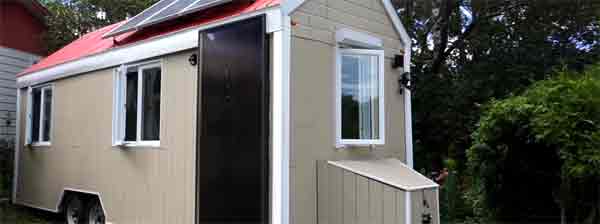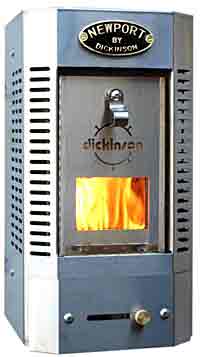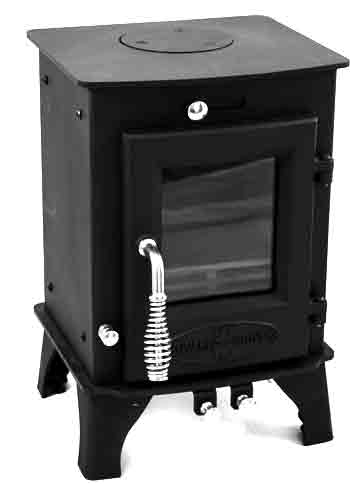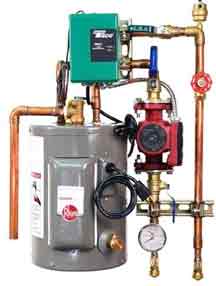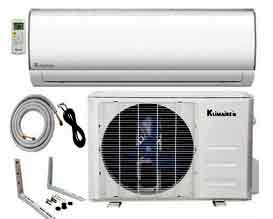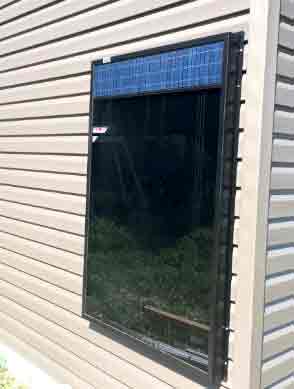Best Ways to Heat Your Tiny Home
If you live in a cold climate you will need to heat your tiny home. Heating a small area like a tiny house is relatively easy. These cozy living spaces can become overheated quite easily, even in cold climates. That being said, I recommend you have two types of heating to ensure continued warmth in the event one of them fails.
Basic Principles To Know Before You Buy
- Understand the advantages, limitations, and possible local zoning regulations for the system you want to install.
- Understand airflow: duct work or no ducting? Fans? Individual room heat?
- Understand the energy requirements for your system within the framework of what is available to you.
Here are the Main Types of Heat Sources You Can Use for a Tiny Home
- Propane (gas furnaces)
- Wood burning stoves, including wood fuel, pellet stoves, and other options. (Also visit our page devoted exclusively to this wood burning stoves.) Please note that this option requires knowledge and consideration of of local zoning regulations, as well as possible restrictions by homeowners insurance policies.
- Hot water heat systems, including hydronic heat, in-floor radiant heat, and under-rug radiant heat. Please note these require either propane or electricity to run the system.
- Electric heat, including mini-splits, radiant floor mats, oil-filled radiant heaters, baseboard heat, electric fireplaces, and electric space heaters.
- Passive solar.
Gas Furnaces
Direct vent space heaters are basically closed combustion boxes that use outdoor air to create heat; any fumes produced by burning propane are vented directly outside your home via a small pipe through an exterior wall.
This direct vent propane wall furnace by Martin produces 20,000 BTU and has a viewing window into the combustion chamber, providing a nice ambience on a cold winter night. It sells for $1,299.00* on Amazon. Click image for more details.
Vent-free propane heaters are less expensive to install than direct vent heaters and offer greater installation flexibility, since they don’t require access to an external wall for venting. However, unlike direct vent options, exhaust is released inside the home. For this reason, it is not legal to install vent-free heaters in rooms where people sleep, and some local building codes do not allow them to be installed at all.
Avoid using non-vented propane heaters like Little Buddy. See more about the dangers of low-level carbon monoxide poisoning on this page: Carbon Monoxide Detectors in Tiny Homes
Suburban NT-34SP Propane RV Furnace
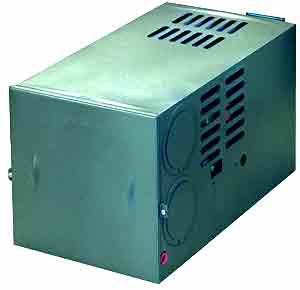 Straight from the RV industry, these miniature furnaces are a tried and true method to heat your tiny home.
Straight from the RV industry, these miniature furnaces are a tried and true method to heat your tiny home.
Suburban has been making RV furnaces for decades. You’ll find them in all of the larger trailers. Why? Because this one produces 40,000 BTU and requires ducting, sending warm dry air to the far reaches of your tiny home. It also has 120 volt motors which is perfect for a tiny home with shore power.
Available from Amazon for $1,038.59*. Weighs 42 lbs. Measures: 23 x 12 x 12.5 inches
Suburban Furnaces require that a minimum duct area be maintained throughout the entire duct system, including through the register. It is very important to adhere to the minimum duct area in order to keep the furnace from cycling on high limit and to assure proper operation of the sail switch.
You will need these accessories to complete installation: duct collar, ducting, and RV air duct outlets.
Advantages of a propane gas furnace
- A propane furnace supplies immediate steady warmth, which is thermostatically controlled.
- It can run safely for many hours without supervision and can be used as a primary heat source.
- The heat can be ducted to different parts of the structure.
- Using gas removes this task from your other energy systems. It requires 120 volts to run the igniter and the fan.
- They are relatively lightweight and inexpensive and clean to use.
- The fire box is vented outside so you get only warm dry air inside.
Disadvantages of a propane gas furnace
- The propane furnace needs to be built into a cabinet, reducing valuable storage space. But, a heater is going to have to go somewhere.
- You will have the expense of propane and the necessity of refilling a propane tank. If you are staying in the same place for a long time, you may find a local propane company that will bring you a large tank, returning monthly to refill it.
- In the extreme cold, the additive in the propane that makes the odor clog the intake line and stop the gas from flowing. The feed line needs to be disconnected and allowed to drain to get the propane flowing again.
Dickinson Marine Propane Fireplace
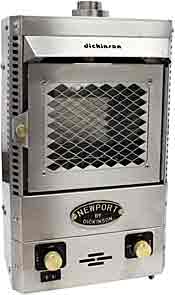
You have probably seen the Dickinson Marine Newport P9000 Propane Fireplace on the wall of many a tiny home. Designed for yachts and sailboats, it bolts right to the wall. With excellent thermal efficiency, it provides a pleasant atmosphere viewing the flame thru a glass window. It does not have a thermostat and can’t be modified to have one. You open the door and use a long lighter to start it. The control knob ranges from low heat to high. Cost is around $1,126.59*. Produces between 5,000 and 7,500 BTU.
It is safe to use because of the flue venting, but it does use room air for combustion.
Dimensions: 7.25″ (D) x 10″ (W) x 16″ (H). Click on image to see more at Amazon.com
There is also a diesel version for the skoolie crowd.
Important Note about freestanding propane heaters
An open flame (like your cook stove) will produce moisture. Moisture in a super insulated tiny home needs to be vented or it will condense on cold surfaces like windows. They also produce low levels of carbon dioxide.
Wood stoves do not produce moisture and, if vented properly, send all combustion gasses safely outside.
Wood Stoves for Tiny House Heating
I love everything about wood stoves, from gathering firewood to kindling the fire. I love the soothing ambiance of watching the flame thru the window. Luckily, I also like the burned wood smell it adds to the entire interior of the tiny home.
Dickinson makes a wood burning version of of its propane heater shown here on the right. The Newport Solid Fuel Heater is a small, stainless steel, solid fuel heater designed for tiny spaces like boat cabins. This heater burns one to two 1″ thick wood or presto log, a handful of charcoal briquettes, or coal. There is a removable ash drawer and damper control. It requires 3″ diameter chimney parts. A minimum 4ft of chimney is required, and a 6ft straight run with no elbows work best.
Creates a dry heat to dry out moisture. Removable ash drawer for easy cleaning and damper control. Heat output (approx.) Low: 3000 BTU/High: 8000 BTU. The downside is you really have to cut your wood very small. It will exhaust its supply of wood in about 30 minutes.
The Dwarf 3kw Mini Wood Stove is the best I found
After exhaustive searching and comparisons, the Dwarf 3kw mini wood stove is the best pick for a tiny home, RV or skoolie. The Dwarf Wood Stove has all the quality of the best large wood stoves but it’s just 17″ high, 10.25″ wide, and 8.5″ deep.
It weighs in at 75 lbs. due to its sturdy build and is made for full-time use.
The wood needs to be between six and eight inches in length. The flue can be connected to the top or the back. If you connect the flue to the back, you’ll keep the entire top for a cooking surface.
Best of all, this unit has an outside air intake box so you can pipe combustion air directly into the stove. There are several styles of legs available too.
The Dwarf 3kw gives you great control over the combustion environment with separate primary, secondary, and tertiary air-controls. It requires safety clearances of 16” on the sides, and 18” in the back. However, you can reduce required clearances by up to 2/3 with a properly designed heat shield.
The basic box is $795.00* but there is a really nice-looking enamel door, available in several colors. You also get to choose the type of legs you want and an install kit. The install kit comes with everything you need to safely get through the roof of your tiny house, travel trailer, or RV.
For a lot more information about Tiny Wood Stoves visit this page.
Permanent fresh air vent needed in area of the unit
All wood stoves need fresh air for combustion. If you do not supply the air it will draw from every tiny crack or space, allowing the extremities of the tiny house to get very cold. Dwarf Wood Stoves have a direct fresh air intake adapter so you can bring combustion air directly into the firebox without freezing your house. Make sure the wood stove you decide to purchase has this ability.
Other types of solid fuel wood stoves
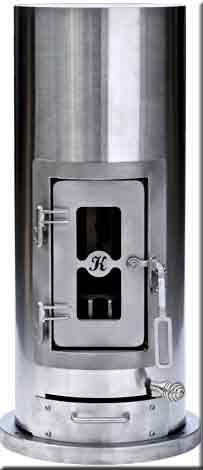 Other versions of wood stoves run on other solid fuel like Wood Fuel Pellets. The pellet stove usually has a system to feed the fuel in slowly. My pellet stove burned a large bag of pellets every two days. The mechanism needed to be cleaned of tar and gunk regularly.
Other versions of wood stoves run on other solid fuel like Wood Fuel Pellets. The pellet stove usually has a system to feed the fuel in slowly. My pellet stove burned a large bag of pellets every two days. The mechanism needed to be cleaned of tar and gunk regularly.
Note: With any heater using combustion, you will need to ensure a source of fresh air. This can come directly thru an air intake duct to the appliance or thru a passive air duct. See my page on proper venting for a tiny home.
The Kimberly Gasifier Wood Stove, shown here, has an intake air vent in the bottom that should be fluted to draw combustion air from outside. It is very compact and needs only a three inch flue for the chimney. Because the chimney flue exits the back, the top remains usable as a cooking surface. The Kimberly Wood Stove is the only one that is RVIA certified for use in RVs. The cost is $3,750.00*
See more about wood stoves on this page
Hot Water Heat Systems
A wood stove should not be the primary way to heat your tiny home. It works well in tandem with a propane heater that can kick on via the thermostat when the wood stove runs out of fuel in the middle of the night. If you are living off-grid, burning wood will lower your dependency on other energy sources.
Hydronic heat
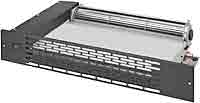
Hydronic heat systems use hot water sent to heat exchangers strategically located around the home. The water is fed using the same Pex tubing as the fresh water system. The heat exchanger shown on the left installs under a cabinet in the toe kick section. A heat exchanger has a section that resembles the radiator of your car (tho very small) and a fan or two to move the air.
Easier than installing duct work for moving warm air, water is sent to various locations in your tiny home or RV. This is a great way to get warm air into the distant master bedroom and each bathroom. Install the toe-kick heat-exchanger under the cabinet that contains the plumbing for the sink. This will also keep the pipes warm so you don’t need to worry about them freezing in the winter.
A boiler is required to make the hot water. Precision Temp makes a combination tankless water heater/hydronic water heater in a small package that is very efficient. Besides being a great tankless water heater, the Precision Temp TwinTemp Junior will supply up to six heat-exchangers. See details about this nifty unit on this page of the Tiny Life Consulting website: Tiny House Water Heaters
The Precision Temp TwinTemp Junior can also be used for in-floor radiant heating.
In-floor radiant heat
In-floor radiant hot water heat is comfortable and quiet. You will never have cold feet again. People rave about the comfort, even in our cold Colorado winters. In-floor radiant heat actually heats the structure rather than warming the air. The advantage is the room heat is very stable. The disadvantage is that it is very slow to change the temperature. It could take an hour to change the room temperature one degree.
However, unless you have serious plumbing skills, it will need to be professionally installed and can be pricey. They require an area for the plumbing shown here.
There are electric in-floor radiant heaters that do not require plumbing. Rather, a wire or panel is laid under the flooring. These are easier to install and while they claim to be “energy-efficient” you will want to be tied to the grid for a good source of electricity.
Radiant-heat floor mats (shown below) slip under area rugs and plug into a standard electrical outlet. These small units might be all you need in a small space like a tiny home.
Under-rug radiant floor heaters
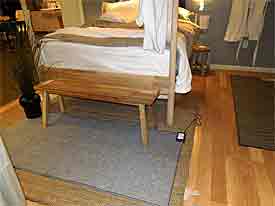
Now you can finally warm up spaces lacking central heat. The Hot Carpet mat fits under carpet or your favorite area rug.
It plugs in to a standard 110 volt outlet and uses about 180 watts. It’s almost enough to warm a tiny house completely.
72″ long by 33″ wide, it fits perfectly in front of your bench seating or sofa.
There are no heating wires to accidentally cut or short-circuit. No step-down transformers, on-site splice connections, or special tools are required.
Electric Heat Options
The mini-split
A mini-split is a type of ductless air conditioner, more properly called a heat pump. These can produce both heating and cooling. They also dehumidify the air, reducing the risk of mold. The inside and outdoor unit are connected with a refrigerant pipe. This piping is easier to install and require less space than traditional heating ducts. Both units need to be connected to electricity. A mini-split, while considered energy-efficient, uses a good deal of energy so it might not be suited for off-grid living. But for tiny homes on-grid, these are a good choice. You can connect more than one inside unit, dispersing the airflow evenly throughout the structure. Click here to find out more.
Other electric heaters
There are a variety of other electric heaters that work well to heat your tiny home.
Passive Solar Heat
Passive solar heat is one of the best ways to heat your tiny home. A heat box like the one shown here is mounted to the outside of the tiny home. It has an intake vent and outflow vent on the back which need to be cut thru the wall.
The solar panel runs the sensors and fan and will activate the unit automatically when the passive solar box is warmer than the air inside the tiny home.
There are different size panels depending on the square footage of the room you need to heat.
Passive solar heat can be use to supplement your main heat system on a sunny day. It’s great for sheds, garages, crawl spaces, and green houses.
Jump to my blog for more information on heating and venting your tiny house.
Here is a good YouTube video about heating your tiny home:
Here is a link to a site that will help you calculate the amount of BTUs your heater will need to produce to properly heat your tiny home.
Air movement
Creating heat is only one aspect of a complete HVAC system. You must also get the heat where it needs to go. In a very small tiny home, say 140 sq/ft, you might be fine with a single point heat source. But with a larger tiny home, you’ll need some ducting.
The propane heater at the top of the page has ports in the back and sides for flexible vent pipe (like dryer vent hose). In an RV, some of the heat will be sent to the bathroom. Another vent will direct heat to the rear of the main living space, while another vent directs heat to the front of the main living space.
When you have no air ducts
If you are heating with a wood stove, you will need to use fans to move air into the bathroom and to far corners of the house. There are some nifty in-wall fans made to move air from one room to another.
Here is a great YouTube® video showing how to plan and install air ducts:
How Not to Heat a Tiny House
Never use a free-standing propane heater in your tiny home. Here’s why.
How to keep the heat you’ve generated
See this post: RV Winter Living: How to Prepare. A lot of good information about skirting.


